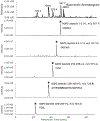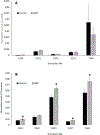Acceleration of age-induced proteolysis in the guinea pig lens nucleus by in vivo exposure to hyperbaric oxygen: A mass spectrometry analysis
- PMID: 34233175
- PMCID: PMC8429224
- DOI: 10.1016/j.exer.2021.108697
Acceleration of age-induced proteolysis in the guinea pig lens nucleus by in vivo exposure to hyperbaric oxygen: A mass spectrometry analysis
Abstract
Hyperbaric oxygen (HBO) treatment of animals or ocular lenses in culture recapitulates many molecular changes observed in human age-related nuclear cataract. The guinea pig HBO model has been one of the best examples of such treatment leading to dose-dependent development of lens nuclear opacities. In this study, complimentary mass spectrometry methods were employed to examine protein truncation after HBO treatment of aged guinea pigs. Quantitative liquid chromatography-mass spectrometry (LC-MS) analysis of the membrane fraction of guinea pig lenses showed statistically significant increases in aquaporin-0 (AQP0) C-terminal truncation, consistent with previous reports of accelerated loss of membrane and cytoskeletal proteins. In addition, imaging mass spectrometry (IMS) analysis spatially mapped the acceleration of age-related αA-crystallin truncation in the lens nucleus. The truncation sites in αA-crystallin closely match those observed in human lenses with age. Taken together, our results suggest that HBO accelerates the normal lens aging process and leads to nuclear cataract.
Keywords: Alpha crystallin; Aquaporin-0; Hyperbaric oxygen; Lens; Mass spectrometry; Nuclear cataract; Protein truncation; αA66-80 peptide.
Copyright © 2021 Elsevier Ltd. All rights reserved.
Conflict of interest statement
Competing Interests
The authors declare no competing interests.
Figures





Similar articles
-
Hyperbaric oxygen in vivo accelerates the loss of cytoskeletal proteins and MIP26 in guinea pig lens nucleus.Exp Eye Res. 1999 Apr;68(4):493-504. doi: 10.1006/exer.1998.0630. Exp Eye Res. 1999. PMID: 10192807
-
Aggregation of lens crystallins in an in vivo hyperbaric oxygen guinea pig model of nuclear cataract: dynamic light-scattering and HPLC analysis.Invest Ophthalmol Vis Sci. 2005 Dec;46(12):4641-51. doi: 10.1167/iovs.05-0843. Invest Ophthalmol Vis Sci. 2005. PMID: 16303961 Free PMC article.
-
Role of αA-crystallin-derived αA66-80 peptide in guinea pig lens crystallin aggregation and insolubilization.Exp Eye Res. 2015 Mar;132:151-60. doi: 10.1016/j.exer.2015.01.024. Epub 2015 Jan 29. Exp Eye Res. 2015. PMID: 25639202 Free PMC article.
-
Lens aging: effects of crystallins.Biochim Biophys Acta. 2009 Oct;1790(10):1095-108. doi: 10.1016/j.bbagen.2009.05.008. Epub 2009 May 20. Biochim Biophys Acta. 2009. PMID: 19463898 Free PMC article. Review.
-
Hyperbaric oxygen as a model of lens aging in the bovine lens: The effects on lens biochemistry, physiology and optics.Exp Eye Res. 2021 Nov;212:108790. doi: 10.1016/j.exer.2021.108790. Epub 2021 Oct 11. Exp Eye Res. 2021. PMID: 34648773 Review.
Cited by
-
Data-independent acquisition parallel accumulation-serial fragmentation (diaPASEF) analysis of the separated zebrafish lens improves identifications.bioRxiv [Preprint]. 2025 Mar 15:2025.03.13.642445. doi: 10.1101/2025.03.13.642445. bioRxiv. 2025. Update in: J Am Soc Mass Spectrom. 2025 Jul 2;36(7):1503-1509. doi: 10.1021/jasms.5c00087. PMID: 40161624 Free PMC article. Updated. Preprint.
-
Lens Aquaporins in Health and Disease: Location is Everything!Front Physiol. 2022 Apr 19;13:882550. doi: 10.3389/fphys.2022.882550. eCollection 2022. Front Physiol. 2022. PMID: 35514349 Free PMC article. Review.
-
Imaging Cataract-Specific Peptides in Human Lenses.Cells. 2022 Dec 14;11(24):4042. doi: 10.3390/cells11244042. Cells. 2022. PMID: 36552806 Free PMC article.
-
Data-Independent Acquisition Parallel Accumulation-Serial Fragmentation (diaPASEF) Analysis of the Separated Zebrafish Lens Improves Identifications.J Am Soc Mass Spectrom. 2025 Jul 2;36(7):1503-1509. doi: 10.1021/jasms.5c00087. Epub 2025 Jun 9. J Am Soc Mass Spectrom. 2025. PMID: 40489690 Free PMC article.
-
UV light and the ocular lens: a review of exposure models and resulting biomolecular changes.Front Ophthalmol (Lausanne). 2024 Sep 5;4:1414483. doi: 10.3389/fopht.2024.1414483. eCollection 2024. Front Ophthalmol (Lausanne). 2024. PMID: 39301012 Free PMC article. Review.
References
-
- Anderson DM, Floyd KA, Barnes S, Clark JM, Clark JI, Mchaourab H and Schey KL, 2015. A method to prevent protein delocalization in imaging mass spectrometry of non-adherent tissues: application to small vertebrate lens imaging. Anal Bioanal Chem. 407, 2311–2320. 10.1007/s00216-015-8489-5 - DOI - PMC - PubMed
-
- Borchman D, Giblin FJ, Leverenz VR, Reddy VN, Lin LR, Yappert MC, Tang D and Li L, 2000. Impact of aging and hyperbaric oxygen in vivo on guinea pig lens lipids and nuclear light scatter. Invest Ophthalmol Vis Sci. 41, 3061–3073. - PubMed
Publication types
MeSH terms
Substances
Supplementary concepts
Grants and funding
LinkOut - more resources
Full Text Sources
Medical

